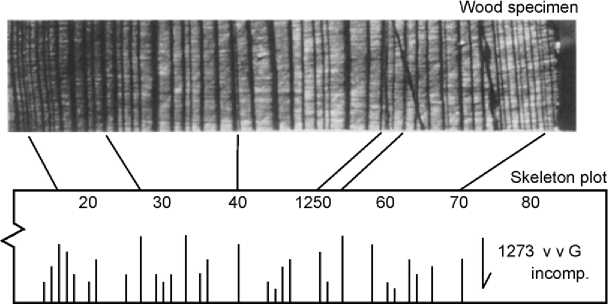To derive a tree-ring date from an archeological wood or charcoal specimen, an analog representation of its tree-ring sequence is recorded on a ‘skeleton plot’ (Figure 4). The width of the growth rings on a given tree-ring specimen are plotted in inverse - narrow growth rings are indicated on the skeleton plot by very tall lines; comparatively wider growth rings are indicated by relatively shorter lines, and wide growth rings indicated by no line at all. Once a skeleton plot has been created for an individual specimen, it can then be compared against those of other specimens to create a master chronology or it is compared against that region’s existing, precisely dated master chronology until the ring-width patterns match up, all missing and double rings have been identified and accounted for, and calendar dates can be identified for each ring on the specimen. Today, sophisticated computerized quantitative techniques can be used to crossdate specimens, build tree-ring chronologies, and date archaeological specimens, but the classic skeleton plot technique is still in use. Even when quantitatively crossdated, good dendrochronologists always go ‘back to the wood’ to confirm the dating suggested by the computer.
Once calendar dates have been identified for all rings on a specimen, the dendrochronologist examines physical characteristics on the outside end of a tree-ring specimen to determine whether the date

Figure 4 The skeleton plot. A schematic summary of growth rings on a tree-ring specimen. Narrow rings are indicated by tall lines, relative wide rings are indicated by short lines or are not noted at all. (Figure courtesy of the Laboratory of Tree-Ring Research, The University of Arizona, Tucson).
Assigned to the outermost ring is a ‘cutting’ or a ‘noncutting’ date. A ‘cutting date’ is assigned when the specimen provides some evidence, in the form of bark, beetle galleries, or other conditions, that the outermost ring on that specimen was the last one grown by the tree before it died. A ‘noncutting date’ is assigned when there is no evidence that the outermost ring present on the specimen was the last one grown before the tree died.
For reasons having mostly to do with preservation issues, noncutting dates are, unfortunately, far more common in archaeological tree-ring dating, even though cutting dates are of much greater analytic utility to the archaeologist. Cutting dates may not necessarily indicate the year of a site’s construction, the year in which a campfire was burned, or the year that an artifact was made, but they do indicate the year in which the tree was harvested or otherwise died, and are therefore much closer approximations of the dates and behaviors of interest to the archaeologist. Noncutting dates are further removed, often by an indeterminate number of years, from the behavior of interest.
Because noncutting dates are so common in archaeological analysis, and prove to be so problematic to archaeological interpretation, archaeologists often rely on ‘date clustering’ to guide their analyses. If a number of noncutting dates from any given feature or site tend to cluster in 1, 2, or 3 years, the archaeologists can infer that tree-ring analysis has identified a prehistoric event, simply because there is little a priori reason to expect noncutting dates to cluster.




 World History
World History









